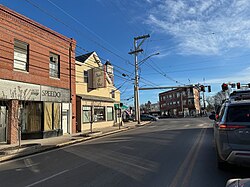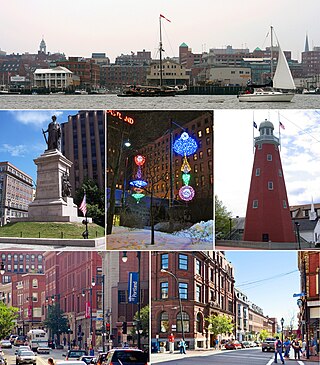
Portland is the most populous city in the U.S. state of Maine and the seat of Cumberland County. Portland's population was 68,408 in April 2020. The Greater Portland metropolitan area has a population of approximately 550,000 people. Historically tied to commercial shipping, the marine economy, and light industry, Portland's economy in the 21st century relies mostly on the service sector. The Port of Portland is the second-largest tonnage seaport in the New England area as of 2019.

Exchange Street is a main commercial thoroughfare in the Old Port of Portland, Maine, United States. Originally laid out in 1724, today it features a number of designer clothing stores, as well as several small, locally owned businesses, including Sherman's Maine Coast Books. It runs, one-way, for around 0.24 miles (0.39 km), from Congress Street in the northwest to Fore Street in the southeast. Its main intersections are with Congress Street, Federal Street, Middle Street and Fore Street.
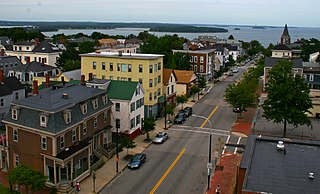
Munjoy Hill is a neighborhood and prominent geographical feature of Portland, Maine. It is located east of downtown and south of East Deering, the neighborhood via Tukey's Bridge. In the nineteenth and twentieth centuries, the neighborhood had a large Irish and Italian American population.

State Road 77 is a major north–south artery in Florida's Panhandle, connecting Panama City to the south with Alabama State Route 109 and Dothan, Alabama to the north.
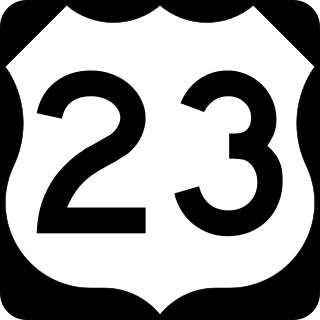
U.S. Highway 23 (US 23) in the U.S. state of Georgia is a north–south United States Numbered Highway that travels from the St. Marys River south-southeast of Folkston to the North Carolina state line, in the northern part of Dillard. At nearly 392 miles (631 km) in length, it is the longest U.S. Highway in Georgia.
Portland, Maine, is home to many neighborhoods.

The Sparrow House is an historic house at 35 Arlington Street in the Woodfords Corner and Back Cove neighborhood of Portland, Maine. Built in 1852, it is a well-preserved example of Gothic Revival architecture. It was listed on the National Register of Historic Places in 1982.

Franklin Street is a four-lane street in Portland, Maine, United States. It is a major corridor for traffic from Interstate 295 to Portland's downtown, Old Port, and to other neighborhoods located on the Portland peninsula. Part of U.S. Route 1A, it is around 0.77 miles (1.24 km) long, running between Marginal Way in the northwest and Commercial Street in the southeast.
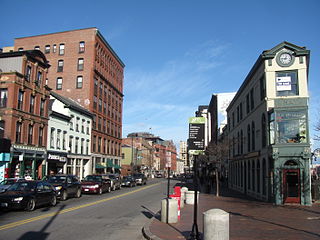
Congress Street is the main street in Portland, Maine. Around 5.77 miles (9.29 km) long, it stretches from County Road, Portland's southwestern border with Westbrook, through a number of neighborhoods, before ending overlooking the Eastern Promenade on Munjoy Hill. In March 2009, the Portland City Council designated much of the inner portion of Congress Street a historic district. The western section of the street includes the city's Arts District.

Forest Avenue is a major street in Portland, Maine, United States. It runs for around 4.78 miles (7.69 km), from Bridgton Road in the northwest to Congress Street, in downtown Portland, in the southeast. It is the main artery for traffic entering and leaving Portland to and from the west via city streets. Forest Avenue passes to the south of Back Cove, while Washington Avenue passes to its north. The street ends in Portland's Arts District.
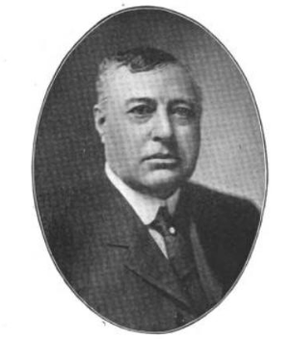
Edward A. Newman was a prominent businessman from Portland, Maine, United States. He was general manager of the Portland Railroad Company and vice-president of the New England Street Railway Club. He was well known among the street railway community of the United States, and during his tenure, Portland's streetcar service was recognized as the best in the country.
Chauncey Woodford was a merchant and an early settler of Deering, Maine. Portland's Woodfords Corner is now named for him and his brothers, Ebenezer and Isaiah.

State Street is a downtown street in Portland, Maine, United States. Part of Maine State Route 77, it runs one-way for around 0.95 miles (1.53 km), from an intersection with Forest Avenue in the northwest to York Street in the southeast. It is one of the three main routes crossing the Portland peninsula in this direction, the other two being High Street and Franklin Street. Part of the street passes through the Deering Street Historic District.

High Street is a downtown street in Portland, Maine, United States. It runs one-way for around 0.81 miles (1.30 km), from Commercial Street in the southeast to Forest Avenue in the northwest. It is one of the three main routes crossing the Portland peninsula in this direction, the other two being State Street and Franklin Street. Part of the street passes through the Spring Street Historic District and the city's Arts District.

India Street is a downtown street and neighborhood in Portland, Maine, United States. Situated near the western foot of Munjoy Hill, it runs for around 0.28 miles (0.45 km), from Congress Street in the northwest to Commercial Street and Thames Street in the southeast. It was the city's first street, and the location of the first settlement of European immigrants to the city in the 17th century. There are thirty handmade bricks in the sidewalk commemorating the neighborhood's notable events. In 1680, when Thomas Danforth was Deputy Governor of the Massachusetts Bay Colony, the street was known as Broad Street. After the incorporation of the Town of Falmouth in 1718, the street was known as High King Street.

Portland station was a passenger rail station on the Grand Trunk Railway in Portland, Maine, United States. It stood to at the foot of India Street, Portland's first street, between 1903 and 1966. It was one of Portland's four railroad stations for the Portland and Forest Avenue Railroad Company over its history, and one of the two stations in the city at the time of the station's construction. The other was Union Station, which has also been demolished.

Stevens Avenue is a major street in the Deering neighborhood of Portland, Maine, United States. Part of Maine State Route 9 from Woodford Street southward, it runs for around 2 miles (3.2 km) from Forest Avenue, at Morrill's Corner, in the north to Outer Congress Street in the south. Stevens Avenue passes to the west of Woodfords Corner. Between Morrills Corner and Woodfords Corner, Stevens Avenue is linked to Forest Avenue by several side streets.

Morrills Corner is a neighborhood and major intersection in Portland, Maine, United States. Centered around the intersections of Forest Avenue, Allen Avenue and Stevens Avenue. It was once home to some of the oldest families in what was the city of Deering.

Washington Avenue is a major street in Portland, Maine, United States. It runs for around 5.25 miles (8.45 km), from Auburn Street in the northwest to Congress Street in the southeast. It continues in parallel with Interstate 295 as it crosses Tukey's Bridge between exits 8 and 9. It is the main artery for traffic entering and leaving Portland to and from the north via city streets, and has been described as a "gateway to the Portland peninsula." Washington Avenue passes to the north of Back Cove, while Forest Avenue passes to its south.

Portland Railroad Company (PRR) was a trolleycar service that was based Portland, Maine, between 1860 and 1941.
